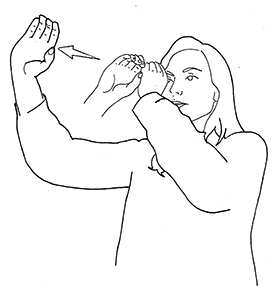In France, an Encyclopedic Astronomical Dictionary for the French sign language (LSF) was published in 2009 by the editor Burillier, in the framework of the International Year of Astronomy (IYA2009) with the support of the Paris Observatory, under the leadership of Dominique Proust, a Paris Observatory astrophysicist, in collaboration with Daniel Abbou, NasroChab, Yves Delaporte, Carole Marion and Blandine Proust.
This dictionary contains about 300 signs for not only the various classical celestial bodies (planets, asteroids, stars, galaxies, quasars etc.)but also technical terms (telescope, spectrograph, photometry…).

Entitled “Hands in the Stars”
This dictionary was the start of a huge project developed under the auspices of the International Astronomical Union (IAU), within the commission Astronomy for Equity and Inclusion.
Now accessible on line, the new expanded version includes translations in English and Spanish, enabling the understanding and the comparison of bodies in the various different sign languages. More languages have been added, in particular German, Portuguese, Japanese, Italian, Polish, etc.
This work was carried out in collaboration with Amelia Ortiz-Gil (Observatorio Astronomico Universidad de Valencia, Espagne) and Beatriz Garcia (IteDA Mendoza, National Tech. University, Faculty Mendoza, Argentine). The English translation was done by Lawrence Augustin Orchard.
This on-line dictionary gathers together the essential elements of astronomy, in order to cast them into sign language (SL), whence its encyclopedic structure.
Each element is accompanied by a drawing of the corresponding sign, as well as a description describing what the various parameters of each sign signify. In the case of ancient signs, this comment also has an etymological background.

Given the rich assortment of celestial bodies, this dictionary will evolve, and in particular takes into account the variety of teaching programs in different countries.
It is more than likely that such compilations will evolve with time through their use by deaf persons, either because fresh knowledge will lead to a better semiological adaptation or because, like all living languages, the various varieties of sign language change with time, essentially via a transition from complex signs to simpler structures.
Have collaborated for this project :
Audrey Cameron (University d’Edinburg), Lina Canas (IAU Office for Astronomy Outreach), Wanda Liz Díaz-Merced (IAU Office of Astronomy for Development), Kevin Govender (IAU Office of Astronomy for Development), Hazel Lowe (Imperial College, London), Kate Meredith (Interim Director of Education Outreach, Yerkes Observatory), Jacob Noel-Storr (InsightSTEM Researcher in Astronomy), Lawrence Augustin (Gus) Orchard (Weedon, Bucks), Jason Nordhaus (National Technical Institute for the Deaf, Rochester Institute of Technology), Gary A. Quinn (Heriot Watt University), Cassandra Runyon (College of Charleston Astronomer, expert in all kind of disabilities), Akihiko Tomita (Wakayama University, Researcher in Astronomy), Kumiko Usuda-Sato (National Astronomical Observatory of Japan Astronomy outreach), Anna Voelker (The Ohio State University), Mike Simmons (Astronomers without Borders), Daniela Pimenta (Planetario de Londrina / PR Brazil), Yudhiakto Pramudya (Universitas Ahmad Dahlan Yogyakarta).


